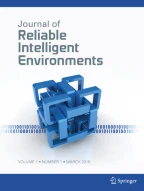Abstract
Internet of Things is an increasing technology that has recently seen growth in the field of research. In a 6LoWPAN network, congestion at nodes is caused by huge network traffic, which reduces the overall performance, as well as the quality of routing metrics. Congestion in IoT network affects various performance measures such as energy inefficiency, decrease in throughput and loss of data packets. Therefore, in this paper, congestion avoidance using fuzzy logic algorithm has been proposed to avoid congestion by selecting the best parent in a tree-structured IoT network to find the optimal routing path. Fuzzy weighted sum model is used to model the problem of parent selection into multi-attribute decision making based problem. Routing metrics used are buffer occupancy, expected transmission count and routing metric (RtMetric). The objective function selects, the parent based on the combination of these routing metrics. The proposed algorithm’s dynamic nature can identify the congestion and then selects the non-congested path by selecting the best parent and thus creates a best routing path for the packets. The algorithm has been implemented and simulated on Contiki OS and a comparison of performance is carried out against optimization-based hybrid congestion alleviation (OHCA) and queue utilization-based RPL (QU-RPL) algorithms. Simulation results indicate that the proposed algorithm has 15% more throughput, 10% more goodput, 4.5% less packets loss, 10.1% less energy use, and 19% less one-way delay over OHCA and QU-RPL algorithms.






















Similar content being viewed by others
Explore related subjects
Discover the latest articles, news and stories from top researchers in related subjects.References
Shreyas J, Dilip Kumar SM (2019) A Survey on Computational Intelligence Techniques for Internet of Things. In: International Conference on Communication and Intelligent Systems, Springer, Singapore, PP 271–282
Shreyas J, Singh H, Bhutani J, Pandit S, Srinidhi NN, Dilip Kumar SM (2019) Congestion Aware Algorithm using Fuzzy Logic to Find an Optimal Routing Path for IoT Networks. In: International Conference on Computational Intelligence and Knowledge Economy (ICCIKE), IEEE, pp. 141–145
Shreyas J, Jumnal A, Dilip Kumar SM, Venugopal KR (2020) Application of computational intelligence techniques for internet of things: an extensive survey. International Journal of Computational Intelligence Studies 9, 3:234–288
Yang Z, Chang CH (2019) 6LoWPAN Overview and Implementations. In: International Conference on Embedded Wireless Systems and Networks (EWSN) 2019 25–27 February, Beijing, China, pp. 357–361
Peres B, Santos BP, Otavio AO, Goussevskaia O, Vieira MA, Vieira LF, Loureiro AA (2018) Matrix: Multihop address allocation and dynamic any-to-any routing for 6lowpan. Comput Netw 140:28–40
Qiu Y, Ma M (2018) Secure group mobility support for 6lowpan networks. IEEE Internet Things J 5(2):1131–1141
Raoof A, Matrawy A, Lung C-H (2018) Routing attacks and mitigation methods for RPL-based Internet of Things. IEEE Communications Surveys & Tutorials 21, no. 2 pp 1582–1606
Chan CO, Lau HC, Fan Y (2018) Iot data acquisition in fashion retail application: Fuzzy logic approach. In: 2018 international conference on artificial intelligence and big data (ICAIBD). IEEE, pp 52–56
Kim H, Paek J, Bahk S (2015) Qu-rpl: Queue utilization based rpl for load balancing in large scale industrial applications. 06
Al-Kashoash H (2020) Optimization-based hybrid congestion alleviation. In: Congestion Control for 6LoWPAN Wireless Sensor Networks: Toward the Internet of Things, Springer, Cham, pp 135–156
Kim H, Kim H, Paek J, Bahk S (2017) Load balancing under heavy traffic in RPL routing protocol for low power and lossy networks. IEEE Trans Mob Comput 16(4):964–979
Sunitha G, Kumar SD, Kumar BV (2017) Energy balanced zone based routing protocol to mitigate congestion in wireless sensor networks. Wirel Pers Commun 97(2):2683–2711
Hassan R, Jubair AM, Azmi K, Bakar A (2016) Adaptive congestion control mechanism in coap application protocol for internet of things (Iot). In: 2016 international conference on signal processing and communication (ICSC). IEEE, pp 121–125
Bhandari K, Hosen A, Cho G (2018) Coar: congestion-aware routing protocol for low power and lossy networks for iot applications. Sensors 18(11):3838. https://doi.org/10.3390/s18113838
Hellaoui H, Koudil M (2015) Bird flocking congestion control for coap/rpl/6lowpan networks. In: Proceedings of the 2015 workshop on IoT challenges in mobile and industrial systems. ACM, pp 25–30
Musaddiq A, Zikria Y, Nain Z, Kim SW (2020) Routing protocol for low-power and lossy networks for heterogeneous traffic network. EURASIP J Wirel Commun Netw 2020:01
Chakravarthi R, Gomathy C (2011) Internet of things: a survey on the security of IoT frameworks. Indian J Comput Sci Eng (IJCSE) 3(3):476–483
Karkazis P et al (2012) Design of primary and composite routing metrics for RPL-compliant wireless sensor networks. In 2012 international conference on telecommunications and multimedia (TEMU), IEEE, pp 13–18
Shen H, Bai G, Zhao L, Ge J, Tang Z (2015) L2or: low-cost lowcomplexity opportunistic routing for wireless sensor networks. Wirel Personal Commun 82(1):401–422
Lamaazi H, Benamar N, Imaduddin MI, Jara AJ (2015) Performance assessment of the routing protocol for low power and lossy networks. In: 2015 international conference on wireless networks and mobile communications (WINCOM). IEEE, pp 1–8
Rathod V, Jeppu N, Sastry S, Singala S, Tahiliani MP (2019) CoCoA++: Delay gradient based congestion control for Internet of Things. J. abb title 100:1053–1072
Author information
Authors and Affiliations
Corresponding author
Additional information
Publisher's Note
Springer Nature remains neutral with regard to jurisdictional claims in published maps and institutional affiliations.
Rights and permissions
About this article
Cite this article
Shreyas, J., Singh, H., Tiwari, S. et al. CAFOR: congestion avoidance using fuzzy logic to find an optimal routing path in 6LoWPAN networks. J Reliable Intell Environ 7, 325–340 (2021). https://doi.org/10.1007/s40860-021-00134-5
Received:
Accepted:
Published:
Issue Date:
DOI: https://doi.org/10.1007/s40860-021-00134-5



